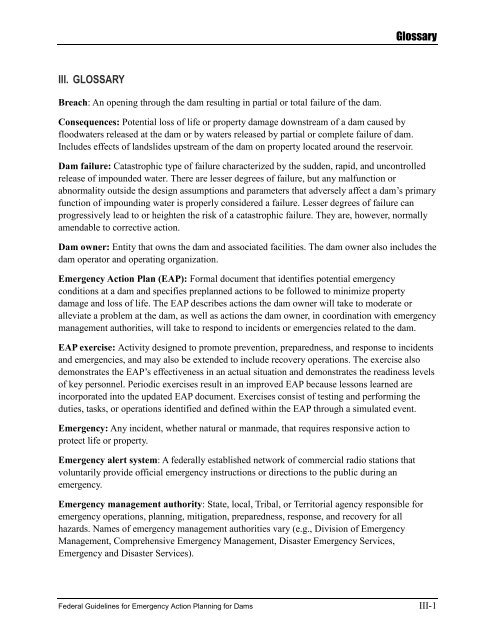Federal Guidelines for Dam Safety: Emergency Action Planning for ...
Federal Guidelines for Dam Safety: Emergency Action Planning for ...
Federal Guidelines for Dam Safety: Emergency Action Planning for ...
You also want an ePaper? Increase the reach of your titles
YUMPU automatically turns print PDFs into web optimized ePapers that Google loves.
GlossaryIII. GLOSSARYBreach: An opening through the dam resulting in partial or total failure of the dam.Consequences: Potential loss of life or property damage downstream of a dam caused byfloodwaters released at the dam or by waters released by partial or complete failure of dam.Includes effects of landslides upstream of the dam on property located around the reservoir.<strong>Dam</strong> failure: Catastrophic type of failure characterized by the sudden, rapid, and uncontrolledrelease of impounded water. There are lesser degrees of failure, but any malfunction orabnormality outside the design assumptions and parameters that adversely affect a dam’s primaryfunction of impounding water is properly considered a failure. Lesser degrees of failure canprogressively lead to or heighten the risk of a catastrophic failure. They are, however, normallyamendable to corrective action.<strong>Dam</strong> owner: Entity that owns the dam and associated facilities. The dam owner also includes thedam operator and operating organization.<strong>Emergency</strong> <strong>Action</strong> Plan (EAP): Formal document that identifies potential emergencyconditions at a dam and specifies preplanned actions to be followed to minimize propertydamage and loss of life. The EAP describes actions the dam owner will take to moderate oralleviate a problem at the dam, as well as actions the dam owner, in coordination with emergencymanagement authorities, will take to respond to incidents or emergencies related to the dam.EAP exercise: Activity designed to promote prevention, preparedness, and response to incidentsand emergencies, and may also be extended to include recovery operations. The exercise alsodemonstrates the EAP’s effectiveness in an actual situation and demonstrates the readiness levelsof key personnel. Periodic exercises result in an improved EAP because lessons learned areincorporated into the updated EAP document. Exercises consist of testing and per<strong>for</strong>ming theduties, tasks, or operations identified and defined within the EAP through a simulated event.<strong>Emergency</strong>: Any incident, whether natural or manmade, that requires responsive action toprotect life or property.<strong>Emergency</strong> alert system: A federally established network of commercial radio stations thatvoluntarily provide official emergency instructions or directions to the public during anemergency.<strong>Emergency</strong> management authority: State, local, Tribal, or Territorial agency responsible <strong>for</strong>emergency operations, planning, mitigation, preparedness, response, and recovery <strong>for</strong> allhazards. Names of emergency management authorities vary (e.g., Division of <strong>Emergency</strong>Management, Comprehensive <strong>Emergency</strong> Management, Disaster <strong>Emergency</strong> Services,<strong>Emergency</strong> and Disaster Services).<strong>Federal</strong> <strong>Guidelines</strong> <strong>for</strong> <strong>Emergency</strong> <strong>Action</strong> <strong>Planning</strong> <strong>for</strong> <strong>Dam</strong>sIII-1
















